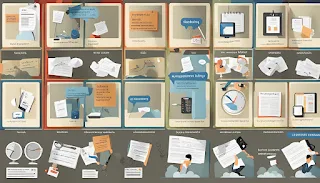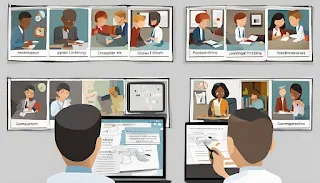A Comprehensive Guide to Mastering Critical Thinking, Problem Solving, Time Management, Communication, and Email Skills

In today's competitive landscape, excelling in critical thinking, problem-solving, time management, communication, and email skills is essential for success. This guide provides valuable tips to help you master these skills.
Critical Thinking
Analyze Syllogisms
1. Understand the Structure: A syllogism consists of two premises and a conclusion. Identify the major premise, minor premise, and conclusion.
2. Check Validity: Ensure the conclusion logically follows from the premises. A syllogism is valid if the conclusion must be true when the premises are true.
3. Identify Terms: Clearly identify the subject, predicate, and middle term. Ensure the middle term is distributed at least once on the premises.
4. Avoid Ambiguities: Watch for ambiguous terms and ensure each term is used consistently.
Make Inferences
1. Read Carefully: Thoroughly read the given information and identify key points.
2. Look for Clues: Identify any implied information or relationships between the given data.
3. Draw Logical Conclusions: Based on the given facts, draw conclusions that logically follow.
4. Verify Consistency: Ensure your inferences do not contradict the given information.
Recognize Assumptions
1. Identify Explicit Information: Determine what is explicitly stated.
2. Spot the Implicit: Look for any information that is assumed but not directly stated.
3. Evaluate Necessity: Assess whether the assumption is necessary for the argument to hold true.
4. Challenge Assumptions: Question the validity and necessity of these assumptions.
Weighing Arguments
1. Identify Main Points: Distinguish between the main argument and supporting points.
2. Evaluate Evidence: Assess the quality and relevance of the evidence provided.
3. Consider Counterarguments: Think about possible counterarguments and how they affect the strength of the argument.
4. Determine Relevance: Ensure the arguments are relevant to the main issue.
Problem-Solving
Creating and Adjusting Schedules
1. Define Tasks: Clearly outline all tasks and their deadlines.
2. Estimate Time: Estimate the time required for each task.
3. Prioritize: Rank tasks based on importance and urgency.
4. Adjust Flexibly: Be prepared to adjust the schedule as new information or tasks emerge.
Interpreting Data and Applying Logic to Make Decisions
1. Understand Data: Ensure you fully understand the data presented.
2. Identify Patterns: Look for trends, patterns, and anomalies in the data.
3. Apply Logical Reasoning: Use logical reasoning to draw conclusions from the data.
4. Make Informed Decisions: Base your decisions on the data and logical conclusions.
Prioritizing and Applying Orders Based on a Given Set of Rules
1. Understand the Rules: Clearly understand the given set of rules.
2. List Tasks: Make a list of tasks or items to be prioritized.
3. Apply Rules Systematically: Apply the rules to organize the tasks in the correct order.
4. Check Consistency: Ensure the final order adheres to all the rules provided.
Applying Textual and Numerical Info to Draw Conclusions
1. Read Carefully: Thoroughly read and understand the textual information.
2. Analyze Numerical Data: Accurately interpret the numerical data.
3. Combine Information: Integrate textual and numerical information to form a comprehensive understanding.
4. Draw Logical Conclusions: Use this integrated understanding to draw logical conclusions.
Time Management
Priority and Planning
1. Set Clear Goals: Define what you need to achieve.
2. Identify Priorities: Rank tasks based on importance and urgency.
3. Create a Plan: Develop a plan that outlines when and how you will tackle each task.
4. Allocate Time: Allocate specific time slots for each task.
Execution
1. Follow the Plan: Stick to your plan as closely as possible.
2. Avoid Procrastination: Start tasks promptly and avoid delays.
3. Monitor Progress: Regularly check your progress against your plan.
4. Adjust as Needed: Be flexible and adjust your plan as necessary.
Communication and Cooperation
1. Keep Stakeholders Informed: Regularly update relevant stakeholders on your progress.
2. Collaborate Effectively: Work effectively with others, leveraging their strengths.
3. Seek Feedback: Request feedback to ensure you are on track.
4. Resolve Conflicts: Address and resolve any conflicts that arise promptly.
Mindset
1. Stay Positive: Maintain a positive attitude towards managing your time.
2. Be Disciplined: Stay disciplined and stick to your plan.
3. Stay Focused: Keep your focus on the task at hand.
4. Practice Self-Care: Ensure you take care of your physical and mental health.
Communication
Understanding and Interpreting Written Communication
1. Read Thoroughly: Read the entire text carefully.
2. Identify Key Points: Highlight the main points and arguments.
3. Analyze Context: Consider the context in which the communication was written.
4. Clarify Ambiguities: Seek clarification for any unclear points.
Listening and Actively Interpreting Non-Verbal Cues
1. Pay Attention: Focus fully on the speaker.
2. Observe Body Language: Note gestures, facial expressions, and posture.
3. Understand Tone: Pay attention to the speaker’s tone of voice.
4. Respond Appropriately: Use non-verbal cues to show understanding and engagement.
Communicating Clearly in a Business Context
1. Be Concise: Get to the point quickly.
2. Use Simple Language: Avoid jargon and complex language.
3. Be Professional: Maintain a professional tone.
4. Ensure Clarity: Make sure your message is clear and unambiguous.
Using Professional Communication Etiquette
1. Formal Salutations: Use appropriate greetings and closings.
2. Polite Language: Use polite and respectful language.
3. Timely Responses: Respond to communications on time.
4. Proofread: Check for spelling and grammar errors before sending.
Email Skills
Basic Email Functionalities
1. Compose Emails: Know how to write and format emails.
2. Attachments: Understand how to attach files to an email.
3. CC and BCC: Use CC for visible recipients and BCC for hidden recipients.
4. Search and Organize: Use email search functions and organize emails into folders.
Email Etiquette
1. Clear Subject Lines: Use descriptive subject lines.
2. Professional Tone: Maintain a professional tone.
3. Brief and Clear: Keep emails concise and to the point.
4. Proper Sign-Offs: Use appropriate email closings and signatures.
Using Gmail
1. Gmail Interface: Familiarize yourself with the Gmail interface.
2. Labels and Filters: Use labels and filters to organize emails.
3. Gmail Features: Utilize features like snooze, schedule send, and priority inbox.
4. Search Operators: Learn Gmail search operators for efficient searching.
Making Google Calendar and Events
1. Create Events: Know how to create events in Google Calendar.
2. Invite Participants: Understand how to invite others to events.
3. Set Reminders: Use reminders to stay on top of events.
4. Share Calendars: Share your calendar with others for collaboration.
.jpg)
**Rodgers Munene**


.jpg)
Comments
Post a Comment